Why tomatoes crack when ripe in a greenhouse: identify the cause and effectively fight it
The world's largest tomato was grown in 2016 in the USA and weighed 3.9 kg. True, this giant tomato was covered with cracks, which is not surprising given its size.
In our country, tomatoes do not grow to this size, but when grown in greenhouses, you can get an excellent harvest. However, the ripening process is often overshadowed by the same problem as the giant American tomato - the appearance of cracks in the skin of tomatoes. In the article, we will tell you in detail why tomatoes crack when ripe in a greenhouse and about methods of combating cracking.
The content of the article
Cracked tomatoes - how dangerous it is
When the crop is ripe in the greenhouse, it is often possible to find fruits with cracked skin on the bushes. And if the tomatoes are planned to be eaten immediately (or put up for processing), then this is not critical.
Moreover, if the infection or mold fungi do not immediately penetrate the inside of the tomatoes, the crack is covered with cork and the crop can be stored in this form for several days.
But when grown for sale, bursting vegetables become a problem: their shelf life is reduced, and the presentation is spoiled. If fungi and bacteria enter through the cracks, the red-pink and yellow fruits become unusable.
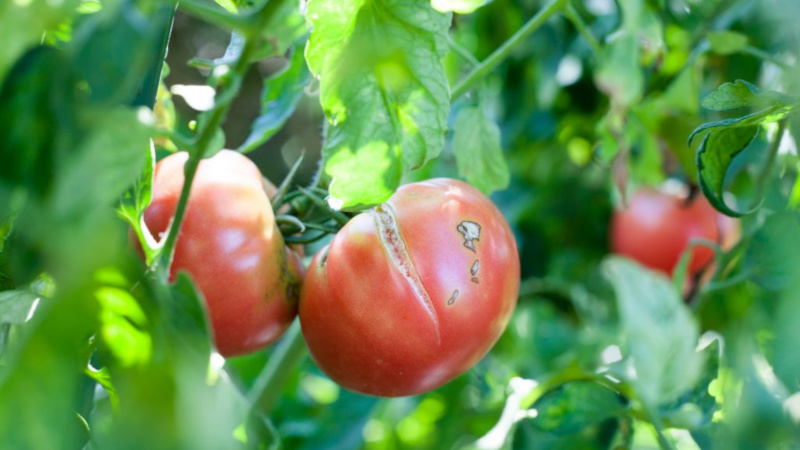
Reasons for the appearance of cracks in tomatoes in a greenhouse
The main causes of cracks are improper growing conditions. Let's consider each of the reasons in detail.
Irregular and too abundant watering
Most often, greenhouse tomatoes burst due to irregular watering.
Remaining in dry soil, vegetables slow down their growth, and the skin on them loses its elasticity. And if, after a week's break, you begin to water abundantly, this will cause intensive fruit growth. The skin, unable to withstand the pressure from the inside, bursts. This can happen not only on ripe vegetables, but also on green ones.
The same thing happens if abundantly water the beds in the heat, pouring the entire volume of water under the root at once.
Excessive pinching of shoots and breaking off leaves
Knowing the benefits pinching, some gardeners are too addicted to it. But the fact is that the roots consume water from the ground in accordance with the volume of green mass of the entire plant. And after removing a large number of stepsons and leaves, excess moisture can only enter the fruit.
The fewer side branches and leaves of a tomato bush become, the more water accumulates in the fruits, causing them to grow rapidly. At the same time, the skin does not keep pace with the growth of the fruit and bursts.
The same thing happens if you overdo it with pinching the top of the bush during the ripening of the crop. The total area of evaporation of moisture is significantly reduced, the fruits are quickly poured, cracks form on their surface.
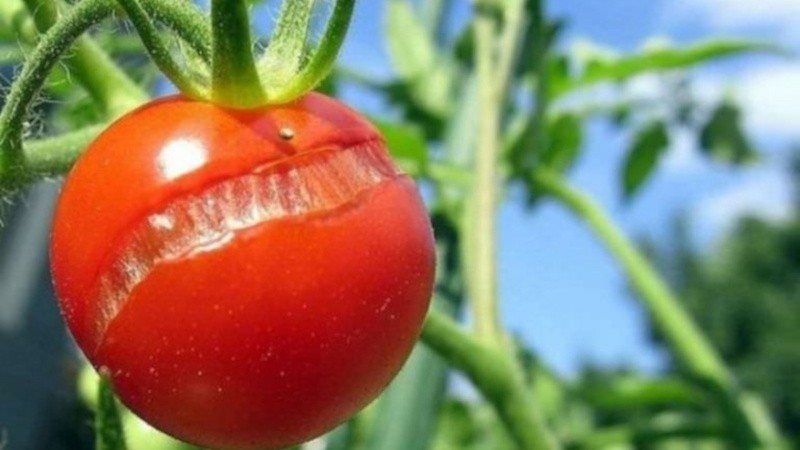
Diseases of tomatoes
These juicy vegetables sometimes crack due to diseases that develop during ripening. As a result of damage, the tomatoes not only burst, but also become unusable.
The most dangerous for the outer shell of the fruits of this culture: Alternaria or dry spot, top rot, late blight... The causes of diseases in greenhouses are insufficient ventilation and excessively high air humidity.
Systemic fungicides, special microbiological preparations (for example, "Fitosporin") and combined fungicides (such as "Ridomil Gold MC") will help to correct the situation.
But the most effective prevention of diseases is constant daytime airing, removal of lower leaves, reduction of air humidity in the greenhouse, preventive spraying with drugs.
Unsuitable temperature or changes in temperature
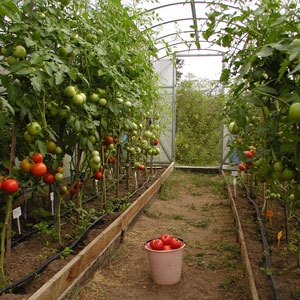
Unfavorable temperature conditions for growing tomatoes often lead to the appearance of bursting fruits.
In hot weather, the temperature in the greenhouse can rise to a critical point for tomato bushes (40 ° C and above). The heat makes the skin of the tomato coarser, inelastic, and when the growth of the fruit accelerates, its outer shell breaks.
The sharp contrast between daytime and nighttime temperatures negatively affects the integrity of the tomato skin.
Wrong choice of variety
Ultra early ripening hybrids with delicate flesh and thin skin are most susceptible to cracking. This problem is especially common with yellow and pink tomato varieties. Tomatoes of large-fruited varieties often burst (regardless of their color).
Fertilization errors
Often, the tomato crop begins to crack in greenhouse beds due to improper or untimely fertilization for them.
Cracking is promoted by excess nitrogen or the application of concentrated fertilizers. Also, the skin of the fruit bursts, and with a lack of essential trace elements.
Attention! The use of concentrates will cause cracks in the outer shell of the tomato.
Why are cracks dangerous?
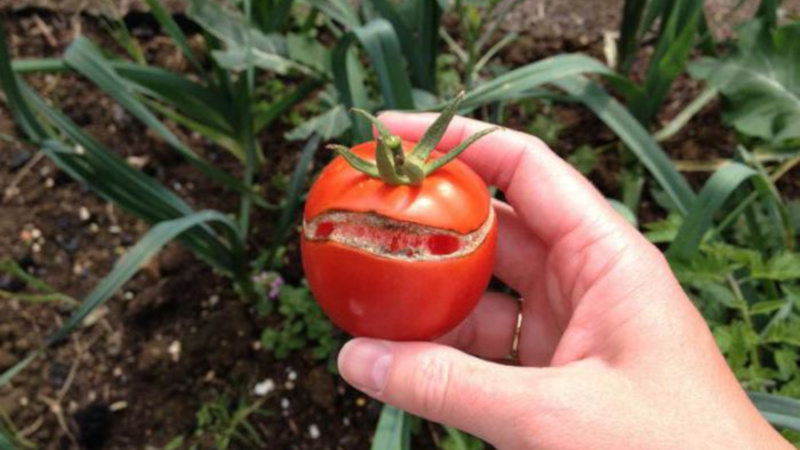
Cracked skin on tender vegetables can spoil much of the crop. Fungi and bacteria easily penetrate into burst fruits, the process of decay begins, and all the work of the vegetable grower goes down the drain.
In addition, cracked tomatoes are stored much less than whole fruits. If the violation of the integrity of the shell is caused by diseases, it is dangerous to eat such fruits.
Tomato varieties that are not prone to cracking
When choosing tomato varieties for your site, pay attention to those that are easier to tolerate tolerances in care. There are many varieties for greenhouse cultivation that do not tend to break the fruit shell.
Most of them are late ripening or hybrids:
- Bohemia F1 is a hybrid with strong fruits, perfectly tolerates long-term transportation.
- Asteroid - a variety highly resistant to disease. The fruits are large, and the dense skin is less prone to tearing.
- Centaur - a hybrid of large size and resistance to major diseases.
- Raspberry Viscount - a low-growing and unpretentious variety for growing conditions, suitable for long-term storage.
- Our Masha - this variety is well adapted to extreme weather conditions.
- Vladimir F1 is a hybrid with fruits of long storage. Resistant to cracking.
- Farm salting - late-ripening medium-sized variety, the harvest is well stored.
- Boomerang - a hybrid that matures in 90-105 days, perfectly withstands transportation.
- Divo - a variety that is resistant to temperature extremes and damp weather. Unpretentious, crop and disease resistant.
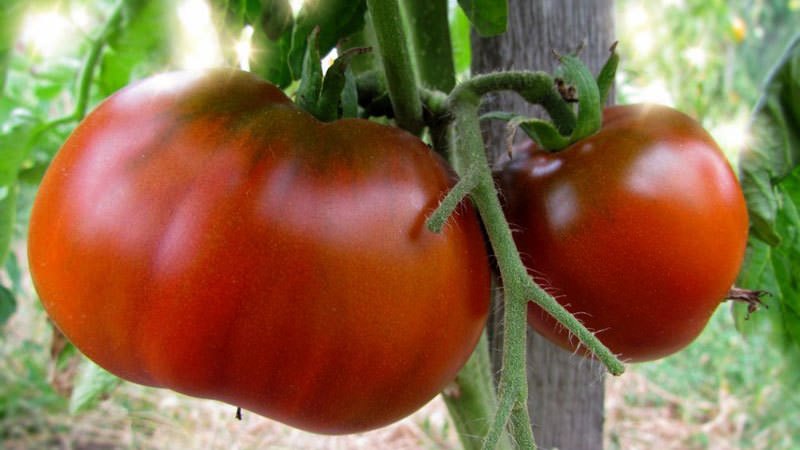
Ways to solve the problem of cracking
If you notice bursting tomatoes in the greenhouse, then using the following simple steps can prevent further damage to the fruit.
Preventive spraying against fungal diseases
Already at the seedling stage, it is necessary to prevent fungal damage to plants in the greenhouse.
Tomato bushes are treated with "Fitosporin-M" solution: for spraying, take 5 g of powder and dilute in 10 liters of water. The procedure is repeated every ten days.
Creation of the necessary microclimate in the greenhouse
To create a microclimate suitable for a fastidious culture, the greenhouse is always ventilated during the day and closed at night. This will prevent sudden changes in temperature.
In hot weather, open all vents and doors for better ventilation and air cooling in the greenhouse. Optimum temperature regime: + 20 ... +28 ° С during the day and + 16 ... +18 ° С at night.
To prevent overheating of delicate plants, the external application of lime milk to the walls and roof of the greenhouse helps.
Experienced gardeners also maintain a suitable level of humidity (55-65%). At higher humidity, constant ventilation throughout the day will help reduce it.
If the air humidity in the greenhouse is much higher than normal, the tomatoes are inevitably affected by fungal diseases.
Removing leaves and pinching bushes
The yield largely depends on how the bush is formed.
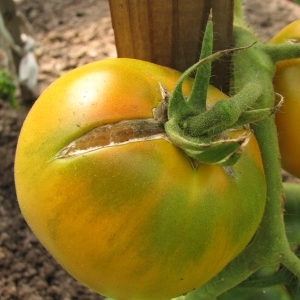
Do not pick off too many leaves, because without them the balance of moisture and nutrients in a ripening crop will be disturbed, and cracks will appear.
The first time the leaves are removed 2 weeks after planting the seedlings in the greenhouse. First of all, the leaves that touch the ground are removed (because of them, diseases can begin in the plant).
Moreover, the foliage should be removed gradually - no more than 2-3 leaves per week on each tomato bush.
Pinching is not the removal of lateral shoots, but the tops of the bush to limit the height of the fruiting stem. Thanks to this technique, the fruits ripen faster and burst less.
Important! Pinch the top only after the flowers of the upper inflorescence open, i.e. from the second half of July. At the same time, several leaves are necessarily left above the upper inflorescence - with their help, the fruits will receive nutrients.
Timely pinching of tomatoes
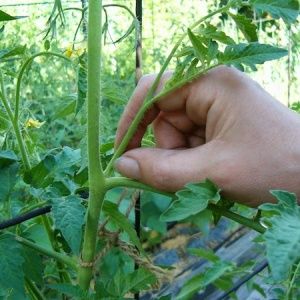
Almost all varieties of tomatoes require removal of stepsons. This is how you help your bushes channel all the juices into the ripening of vegetables.
It is optimal to start the procedure after the first stepson appears under the first flower brush. Do not wait until it grows more than 5 cm in length, otherwise it will have time to draw on precious food.
Docking is carried out in the morning, in dry and warm weather. The optimal frequency of removing stepchildren is once every 7-10 days.
Fertilization and feeding
To prevent cracking of tomato fruits, experienced vegetable growers strictly follow the instructions for breeding fertilizers. To feed greenhouse bushes, it is enough for a wave to dilute fertilizer in a ratio of 20 g per 10 liters of water.
Tears can appear on the skin of tomatoes both with a deficiency and with an excess of microelements and macroelements in the soil.
The scheme for feeding tomato bushes includes the following steps:
- Even before planting tomato seedlings, greenhouse beds should be saturated with fertilizers (nitrogen, potassium and phosphorus).
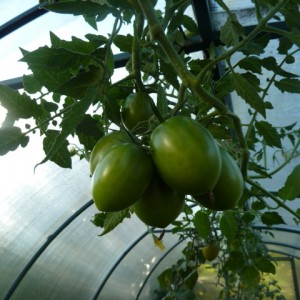
- Two weeks after planting, the bushes are fed with three main elements: nitrogen, phosphorus and potassium, as well as trace elements.
- During the period of active growth, it is useful to fertilize the greenhouse culture with nitrogen and phosphorus.
- During the flowering of tomato bushes, it is advisable to add potassium and phosphorus to the soil (nitrogen is not needed at this stage).
- During the period of fruit setting, it makes sense to feed the plants with potassium and phosphorus again.
- The last feeding is carried out 2 weeks before harvesting (potassium, manganese, boron, iodine).
Moderate and regular watering
In hot weather, optimal water the tomato bushes twice a week in the evening. This will help to avoid accelerated growth and cracking of tomatoes.
In cloudy weather, it is enough to water the greenhouse beds no more than once every five days.When the nighttime temperature drops below 13 ° C, it is more advisable to postpone watering to 11-12 o'clock in the afternoon.
When watering, you cannot immediately pour the entire required volume of water under the bushes - it is necessary to moisten the ground in several steps, waiting for each portion of water to be absorbed.
The ingress of water on the leaves has a detrimental effect on the greenhouse crop. Therefore, the bushes are watered under the root with warm water (temperature 22-25 ° C).
Stopping feeding during the ripening of tomatoes
Many gardeners are of the opinion that it is not necessary to "stuff" vegetables with fertilizers on the eve of harvest. By this time, the fruits of the tomato have already received all the necessary nutrients, so another feeding threatens with an overdose of elements and cracking.
How to Prevent Tomato Cracking in the Greenhouse - Tips and Tricks
Below is a list of steps you can take to help prevent bursting tomatoes.
- Choose varieties that are resistant to cracking.
- Water regularly and evenly after transplanting.
- Maintain an optimal microclimate in the greenhouse (temperature, humidity, ventilation).
- Do not forget to carry out preventive spraying against fungal diseases.
- Perform pinching in a timely manner, but do not get carried away with breaking off the green mass.
- Take measures to prevent diseases of tomato bushes.
- Apply the necessary dressing once every two weeks.
If, when all of the above conditions are met, the tomato crop continues to upset with many bursting fruits, it is recommended to analyze the mineral composition of the greenhouse soil.
Conclusion
To keep your tomatoes smooth and beautiful until harvesting, it is imperative to maintain an acceptable microclimate for them, water regularly, thoughtfully shape the bushes, feed and spray them.